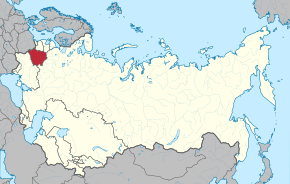Byelorussian Soviet Socialist Republic (1920–1991): Difference between revisions
mNo edit summary Tag: Visual edit |
No edit summary Tag: Visual edit |
||
| Line 1: | Line 1: | ||
{{Infobox country|name=Byelorussian Soviet Socialist Republic|native_name=Беларуская Савецкая Сацыялістычная Рэспубліка<br>Белорусская Советская Социалистическая Республика|image_coat=Emblem_of_the_Byelorussian_Soviet_Socialist_Republic_(1981–1991).svg|capital=Minsk|largest_city=Minsk|mode_of_production=[[Socialism]]|image_map=Map_of_the_Byelorussian_SSR.svg|map_width=290|motto=Пралетарыі ўсіх краін, яднайцеся!|englishmotto=Workers of the world, unite!|image_flag=Flag_of_the_Byelorussian_Soviet_Socialist_Republic_(1951–1991).svg|year_end=1991|year_start=1920|official_languages=Belarusian<br>Russian|recognized_languages=Polish<br>Yiddish|area_km2=207,600|population_census=10,199,709|population_census_year=1989}} | {{Infobox country|name=Byelorussian Soviet Socialist Republic|native_name=Беларуская Савецкая Сацыялістычная Рэспубліка<br>Белорусская Советская Социалистическая Республика|image_coat=Emblem_of_the_Byelorussian_Soviet_Socialist_Republic_(1981–1991).svg|capital=Minsk|largest_city=Minsk|mode_of_production=[[Socialism]]|image_map=Map_of_the_Byelorussian_SSR.svg|map_width=290|motto=Пралетарыі ўсіх краін, яднайцеся!|englishmotto=[[Workers of the world, unite!]]|image_flag=Flag_of_the_Byelorussian_Soviet_Socialist_Republic_(1951–1991).svg|year_end=1991|year_start=1920|official_languages=Belarusian<br>Russian|recognized_languages=Polish<br>Yiddish|area_km2=207,600|population_census=10,199,709|population_census_year=1989}} | ||
The '''Byelorussian Soviet Socialist Republic''' ('''BSSR''') was a republic of the [[Union of Soviet Socialist Republics (1922–1991)|Soviet Union]]. | The '''Byelorussian Soviet Socialist Republic''' ('''BSSR''') was a republic of the [[Union of Soviet Socialist Republics (1922–1991)|Soviet Union]]. | ||
| Line 8: | Line 8: | ||
During the [[Second World War|Great Patriotic War]], [[German Reich (1933–1945)|Germany]] occupied Belarus and killed from 400,000 to 840,000 Jews. The [[Fascism|fascist]] occupiers destroyed over 9,800 cities, towns, and villages. Over 370,000 people fought as partisans against the Nazis.<ref name=":0">{{Web citation|newspaper=Oktyabr|title=The Belarusian SSR: a brief chronology|url=https://oktyabrvperedi.wordpress.com/2020/08/22/the-belarusian-ssr-a-brief-chronology/|archive-url=https://web.archive.org/web/20220824090808/https://oktyabrvperedi.wordpress.com/2020/08/22/the-belarusian-ssr-a-brief-chronology/|archive-date=2022-08-24|retrieved=2022-09-11}}</ref> | During the [[Second World War|Great Patriotic War]], [[German Reich (1933–1945)|Germany]] occupied Belarus and killed from 400,000 to 840,000 Jews. The [[Fascism|fascist]] occupiers destroyed over 9,800 cities, towns, and villages. Over 370,000 people fought as partisans against the Nazis.<ref name=":0">{{Web citation|newspaper=Oktyabr|title=The Belarusian SSR: a brief chronology|url=https://oktyabrvperedi.wordpress.com/2020/08/22/the-belarusian-ssr-a-brief-chronology/|archive-url=https://web.archive.org/web/20220824090808/https://oktyabrvperedi.wordpress.com/2020/08/22/the-belarusian-ssr-a-brief-chronology/|archive-date=2022-08-24|retrieved=2022-09-11}}</ref> | ||
== Education == | == Economy == | ||
By 1941, the BSSR had 25 universities with 21,538 students. By 1959, there were 55,700 university students.<ref name=":0" /> | In 1970, the average monthly income in Belarus was 1,092 rubles, less than the USSR average of 1,194.<ref name=":03">{{Citation|author=Albert Szymanski|year=1984|title=Human Rights in the Soviet Union|chapter=The Asian Nationalities in the USSR|page=38–59|pdf=https://cloudflare-ipfs.com/ipfs/bafykbzaceazdmtb2y3qq27fve5ib3gk7uv2unt6ae2xss74xmfpur7k5uhl5m?filename=Albert%20Szymanski%20-%20Human%20Rights%20in%20the%20Soviet%20Union_%20Including%20Comparisons%20with%20the%20U.S.A.-Zed%20Books%20Ltd.%20%281984%29.pdf|city=London|publisher=Zed Books Ltd.|isbn=0862320186|lg=https://libgen.rs/book/index.php?md5=C597B1232D9EA6B0F3DCB438D7E15A81}}</ref> | ||
== Demographics == | |||
In 1970, 81% of the population of the BSSR were Belarusians and 80.2% of those spoke Belarusian as their native language. 75% of newspapers but only 21% of books in Soviet Belarus were published in Belarusian. [[Russian Soviet Federative Socialist Republic (1917–1991)|Russians]] made up 10.4% of the BSSR's population. Belarusians made up 3.50% of [[Communist Party of the Soviet Union|CPSU]] membership and were slightly underrepresented in the party.<ref name=":03" /> | |||
== Living standards == | |||
=== Education === | |||
By 1941, the BSSR had 25 universities with 21,538 students. By 1959, there were 55,700 university students.<ref name=":0" /> In 1970, there were 14.38 Belarusian university students per 1,000 people, lower than most Soviet nationalities but higher than [[Tajik Soviet Socialist Republic (1929–1991)|Tajiks]] or [[Moldavian Soviet Socialist Republic (1940–1991)|Moldovans]].<ref name=":03" /> | |||
=== Health care === | |||
In 1971, Belarus had 26.7 doctors and 98.5 hospital beds per 10,000 people, slightly lower than the union average.<ref name=":03" /> | |||
== References == | == References == | ||
[[Category:Republics of the Soviet Union]] | [[Category:Republics of the Soviet Union]] | ||
Revision as of 00:23, 5 February 2023
| Byelorussian Soviet Socialist Republic Беларуская Савецкая Сацыялістычная Рэспубліка Белорусская Советская Социалистическая Республика | |
|---|---|
| 1920–1991 | |
Motto: Пралетарыі ўсіх краін, яднайцеся! | |
 | |
| Capital and largest city | Minsk |
| Official languages | Belarusian Russian |
| Recognized languages | Polish Yiddish |
| Dominant mode of production | Socialism |
| History | |
• Established | 1920 |
• Dissolution | 1991 |
| Area | |
• Total | 207,600 km² |
| Population | |
• 1989 census | 10,199,709 |
The Byelorussian Soviet Socialist Republic (BSSR) was a republic of the Soviet Union.
History
Great Patriotic War
During the Great Patriotic War, Germany occupied Belarus and killed from 400,000 to 840,000 Jews. The fascist occupiers destroyed over 9,800 cities, towns, and villages. Over 370,000 people fought as partisans against the Nazis.[1]
Economy
In 1970, the average monthly income in Belarus was 1,092 rubles, less than the USSR average of 1,194.[2]
Demographics
In 1970, 81% of the population of the BSSR were Belarusians and 80.2% of those spoke Belarusian as their native language. 75% of newspapers but only 21% of books in Soviet Belarus were published in Belarusian. Russians made up 10.4% of the BSSR's population. Belarusians made up 3.50% of CPSU membership and were slightly underrepresented in the party.[2]
Living standards
Education
By 1941, the BSSR had 25 universities with 21,538 students. By 1959, there were 55,700 university students.[1] In 1970, there were 14.38 Belarusian university students per 1,000 people, lower than most Soviet nationalities but higher than Tajiks or Moldovans.[2]
Health care
In 1971, Belarus had 26.7 doctors and 98.5 hospital beds per 10,000 people, slightly lower than the union average.[2]
References
- ↑ 1.0 1.1 "The Belarusian SSR: a brief chronology". Oktyabr. Archived from the original on 2022-08-24. Retrieved 2022-09-11.
- ↑ 2.0 2.1 2.2 2.3 Albert Szymanski (1984). Human Rights in the Soviet Union: 'The Asian Nationalities in the USSR' (pp. 38–59). [PDF] London: Zed Books Ltd.. ISBN 0862320186 [LG]

